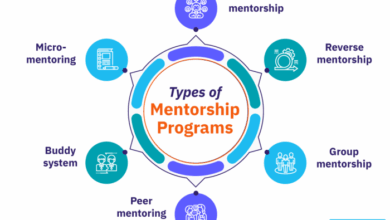
Encourage employee volunteer work – Encouraging employee volunteer work is crucial for boosting company morale, fostering a positive work environment, and contributing to the community. This comprehensive guide dives into the essential elements for establishing successful volunteer programs. From defining various types of activities and structuring programs to motivating participation, measuring impact, and building community partnerships, we’ll explore the entire spectrum of successful volunteer initiatives.
This guide will explore how to craft a program that benefits both your employees and the community by outlining strategies for motivating employees, measuring impact, and ensuring long-term sustainability. We’ll also discuss how to address challenges and build strong community partnerships.
Defining Employee Volunteer Programs
Employee volunteer programs are increasingly important for companies seeking to improve their corporate social responsibility (CSR) initiatives and enhance employee engagement. These programs allow employees to contribute their time and skills to causes they care about while strengthening their sense of purpose and belonging. They can also boost a company’s reputation and attract top talent.A well-structured employee volunteer program can be a powerful tool for creating positive change within the community and fostering a stronger company culture.
This is achieved through carefully designed activities that align with the company’s values and the interests of its employees.
Types of Employee Volunteer Activities, Encourage employee volunteer work
Employee volunteer activities can take many forms, catering to diverse interests and skills. They often range from simple acts of service to more complex projects requiring specialized expertise. Common types of activities include:
- Community service projects: These involve direct service to local organizations, such as food banks, shelters, or environmental cleanup efforts. Examples include assisting at a local soup kitchen, participating in a park cleanup, or mentoring underprivileged youth.
- Skills-based volunteering: This type of volunteering leverages employees’ professional skills to address community needs. For instance, a software engineer might donate their expertise to a non-profit website, or a marketing professional could help a local charity with their branding.
- Fundraising events: These activities aim to raise money for specific causes through organized events, such as walks, runs, or galas. Companies can also sponsor existing events or establish their own.
- Environmental conservation efforts: These involve actions aimed at protecting the environment, such as tree planting, recycling drives, or advocating for sustainable practices. This could involve working with local conservation organizations to restore a habitat or promoting eco-friendly practices within the company.
Volunteer Program Structures
Companies can structure their employee volunteer programs in various ways to best suit their needs and goals. Flexibility and alignment with company values are key.
- Centralized Programs: These programs are managed centrally, with a dedicated team responsible for coordinating all volunteer activities. This approach offers consistent branding and streamlined administration. However, it may not always be tailored to specific employee interests.
- Decentralized Programs: In this model, individual departments or teams organize their own volunteer activities. This approach allows for greater flexibility and caters to employee interests within each department. However, it can lead to inconsistencies in program management and brand messaging.
- Combined Programs: A blend of centralized and decentralized models. A central team sets the overall direction and resources while individual teams or groups have autonomy to choose specific projects and causes.
Pros and Cons of Volunteer Program Models
The effectiveness of a volunteer program often depends on its structure. The following table Artikels the advantages and disadvantages of different program models:
| Program Model | Pros | Cons |
|---|---|---|
| Centralized | Consistent branding, streamlined administration, easier tracking of volunteer hours, efficient resource allocation | Less flexibility for employee interests, potential for bureaucratic processes, might not always cater to specific community needs |
| Decentralized | Greater employee autonomy and engagement, alignment with specific department needs, responsiveness to immediate community needs | Potential for inconsistencies in branding and program management, difficulties in tracking volunteer hours across departments, less efficient resource allocation |
| Combined | Balance between central guidance and local flexibility, caters to a wider range of employee interests, allows for a more tailored approach to community needs | Requires more complex management structure, potentially higher administrative overhead, coordination challenges between different groups |
Motivating Employee Participation
Encouraging employee volunteerism isn’t just about good PR; it’s a powerful way to boost employee engagement and company culture. Motivating employees to participate in volunteer programs requires understanding the underlying psychological factors that drive their actions. A well-structured program can foster a sense of purpose, build camaraderie, and ultimately strengthen the company’s social impact.Understanding the psychological drivers behind volunteerism is key to designing effective programs.
Employees are often motivated by a desire to make a difference, contribute to something larger than themselves, and feel a sense of belonging. Recognizing these intrinsic motivators is crucial for creating a supportive environment that encourages participation.
Psychological Factors Driving Volunteerism
Employees are driven by a complex interplay of intrinsic and extrinsic factors. Intrinsic motivators, such as a sense of purpose, altruism, and personal growth, are deeply ingrained. Extrinsic motivators, like recognition, rewards, and social benefits, play a crucial role in reinforcing and supporting the intrinsic motivations. Ultimately, a well-designed program combines these factors to maximize participation.
Successful Strategies for Encouraging Participation
Several strategies have proven effective in boosting employee participation in volunteer programs. Clear communication about the program’s goals, activities, and impact is essential. Flexible scheduling and convenient locations can significantly increase accessibility and participation. Creating a supportive and inclusive environment where employees feel valued and appreciated is critical.
- Highlighting Impact: Clearly demonstrating the positive outcomes of volunteer efforts, both on the community and the organization, can significantly increase employee engagement. Sharing stories of how volunteers have made a difference, or providing quantifiable data on the impact of the program, helps employees connect their efforts to real results. For example, if a company’s volunteer program has helped a local school raise funds for new equipment, highlighting that achievement can be incredibly motivating.
Encouraging employee volunteer work is a fantastic way to boost morale and team spirit. It’s a win-win for everyone involved, fostering a sense of community and shared purpose. Plus, a company that supports volunteer initiatives often attracts top talent, like those who appreciate the values of a company that invests in its employees’ well-being and the broader community.
Take a look at the luxurious features of the Tesla Model S, in the lap of luxury teslas all electric model s , and you’ll see that investing in employees isn’t just good for the company’s image, it can also lead to improved productivity and innovation. Ultimately, encouraging volunteer work is a great way to cultivate a positive work environment.
- Offering Choice: Providing a range of volunteer opportunities caters to diverse interests and skill sets. Offering different project types and time commitments empowers employees to choose activities that resonate with their personal values and availability. This personalized approach ensures that the program aligns with the needs and preferences of the workforce.
- Recognition and Appreciation: Acknowledging and rewarding volunteer efforts fosters a sense of appreciation and boosts morale. Public recognition, small tokens of appreciation, or opportunities for professional development related to the volunteering experience can greatly motivate employees. For instance, a company could offer volunteer time off or create a special volunteer recognition event.
Role of Leadership in Fostering a Culture of Volunteering
Leadership plays a critical role in establishing a culture of volunteering. Leaders who actively participate and champion volunteer initiatives set a powerful example for their teams. Creating a supportive work environment that values volunteerism, providing resources and encouragement, and actively communicating the benefits are all crucial.
Employee Incentive Programs for Volunteer Work
Different incentive programs can be implemented to encourage employee volunteerism. Each program has distinct benefits and drawbacks.
| Incentive Program | Description | Benefits | Drawbacks |
|---|---|---|---|
| Volunteer Time Off (VTO) | Employees receive paid time off for volunteering. | Increases accessibility, aligns with employee needs, promotes intrinsic motivation. | Can be costly, requires careful planning to avoid disruption of workflow. |
| Matching Donations | Company matches employee donations to charities. | Increases employee financial contribution, aligns with employee values. | Requires administrative effort, potential for misalignment between employee and company values. |
| Skill-Based Volunteering | Employees use their professional skills to support community organizations. | Leverages employee expertise, provides professional development opportunities. | Requires careful matching of skills with community needs. |
| Volunteer Recognition Events | Events to celebrate and acknowledge employee volunteer efforts. | Fosters community, strengthens team spirit, builds morale. | Can be costly to organize, requires careful planning. |
Measuring the Impact of Volunteer Work
Tracking and quantifying the impact of employee volunteer programs is crucial for demonstrating their value to both the company and the community. Understanding the positive effects allows for continuous improvement, stronger engagement, and a more compelling case for future initiatives. Furthermore, measurable results build a strong narrative around the program, reinforcing its importance to employees and stakeholders.Beyond simply counting hours, effective measurement delves into the tangible and intangible benefits.
This includes assessing the program’s contribution to company culture, employee morale, and community development. Quantifiable metrics like volunteer hours, community impact, and cost savings offer a clear picture of the program’s effectiveness. This approach fosters a culture of accountability and transparency, essential for the long-term success of any employee volunteer program.
Key Metrics for Evaluating Effectiveness
Understanding the impact of employee volunteer programs requires careful selection of relevant metrics. These metrics should align with the program’s goals and objectives. Metrics should be measurable and demonstrably linked to the desired outcomes. Examples include the number of volunteer hours logged, the number of individuals or organizations served, and the financial value of the community contributions.
Measuring Positive Impact on the Company
A well-structured employee volunteer program can significantly enhance the company’s image and reputation. It can foster a sense of shared purpose and belonging among employees, which translates into improved morale and productivity. Positive impact on the company can be measured through surveys assessing employee satisfaction, engagement, and commitment. Changes in employee retention rates and productivity levels can also be indicative of the program’s influence on the company’s well-being.
Measuring Positive Impact on the Community
Evaluating the program’s impact on the community requires specific metrics tailored to the types of projects undertaken. For example, if the program focuses on environmental conservation, metrics might include the number of trees planted, the amount of waste collected, or the number of conservation efforts supported. If the program focuses on education, metrics might include the number of students mentored, the number of educational resources provided, or the improvement in student achievement.
Measuring these tangible and intangible impacts is critical to demonstrating the program’s community benefit.
Encouraging employee volunteer work is a fantastic way to boost morale and team spirit. But, with the increasing digital threats, like the vulnerability of your voice mail hugely hackable , we need to be mindful of cybersecurity. Ultimately, a secure and productive workplace, both digitally and socially, benefits everyone, including those who contribute to volunteer initiatives.
Methods for Tracking Volunteer Hours and Impact
A structured approach to tracking volunteer hours and their impact is essential for program evaluation. This involves a well-defined system for recording volunteer activities, ensuring accuracy and consistency in data collection. This systematic approach enables a thorough analysis of the program’s overall effectiveness.
| Tracking Method | Description | Example |
|---|---|---|
| Volunteer Time Tracking System | Software or spreadsheets for logging hours, tasks, and locations. | A dedicated online platform where employees can record their volunteer hours, project details, and community partners. |
| Community Impact Reports | Documentation of the tangible outcomes of volunteer activities. | Detailed reports from partner organizations detailing the assistance received and the impact on the community. |
| Pre/Post Surveys | Collecting data before and after volunteer events to measure the impact on the community. | Surveys administered to community members to assess the impact of volunteer projects. |
Communicating Positive Outcomes
Regularly communicating the positive outcomes of volunteer programs to employees is crucial for maintaining engagement and motivation. This can be done through newsletters, intranet updates, company-wide meetings, or employee recognition programs. Transparent communication fosters a sense of shared accomplishment and pride in the company’s contributions to the community. This also reinforces the program’s value proposition to current and potential employees.
Creating a Supportive Environment
Encouraging employee volunteering isn’t just about offering opportunities; it’s about fostering a culture that values and supports those who want to contribute their time and skills to causes they care about. A supportive environment recognizes the time commitment involved and acknowledges the potential impact on employees’ work-life balance. This supportive environment makes volunteering a rewarding experience, leading to increased employee engagement and a stronger company image.A supportive work environment is crucial for successful employee volunteer programs.
It demonstrates that the company values its employees’ commitment to community involvement, reinforcing the idea that work and personal lives are interconnected and important. This fosters a sense of shared purpose and reinforces the positive impact of collective action.
Importance of Flexible Scheduling and Time-Off Policies
Flexible scheduling and time-off policies are critical components of a supportive environment for employee volunteers. They show employees that their personal commitments are valued and that the company is invested in their well-being. This trust translates into increased employee satisfaction and loyalty. When employees feel supported, they are more likely to volunteer and engage in other company initiatives.
- Reduced stress and burnout: Flexible scheduling allows employees to balance their volunteer commitments with work responsibilities, minimizing stress and preventing burnout. This, in turn, leads to improved employee morale and productivity.
- Increased employee engagement: When employees feel supported in their personal pursuits, they are more likely to be engaged in their work and contribute to the company’s success. Volunteer work can foster a stronger sense of community within the workplace.
- Improved work-life balance: Flexible scheduling allows employees to dedicate time to volunteer work without sacrificing their personal lives. This balance is crucial for their overall well-being and job satisfaction.
Examples of Policies Supporting Employee Volunteering
Many policies can support employee volunteering, demonstrating a company’s commitment to employee well-being and community involvement.
- Paid time off for volunteering: Allowing employees paid time off for volunteer activities explicitly acknowledges the importance of their contributions. This could be a dedicated block of time or part of existing vacation time.
- Flexible work arrangements: This could include remote work options, flexible hours, or compressed workweeks, enabling employees to fit volunteer activities into their schedules without sacrificing work responsibilities.
- Volunteer time off (VTO): Dedicated time off specifically for volunteering is a powerful policy that recognizes the value of employee contributions to the community.
Flexible Work Options for Volunteer Commitments
The following table illustrates various flexible work options for accommodating volunteer commitments.
| Flexible Work Option | Description | Example |
|---|---|---|
| Compressed workweek | Employees work fewer days per week but maintain the same total hours. | Working four 10-hour days instead of five 8-hour days. |
| Flexible hours | Employees can adjust their start and end times within defined parameters. | Starting work at 9 am and ending at 5 pm, or adjusting the schedule based on project needs. |
| Remote work | Employees can work from locations other than the office. | Working from home, a co-working space, or a client location. |
| VTO (Volunteer Time Off) | Designated time off specifically for volunteer activities. | Two days per year for volunteer work. |
Communicating the Value of Volunteering

A strong employee volunteer program hinges not just on its design and implementation, but also on its effective communication. Clear and consistent messaging about the program’s goals, benefits, and impact is crucial for engaging employees and maximizing participation. This communication fosters understanding, promotes enthusiasm, and ultimately drives meaningful contributions.Effective communication transcends simple announcements. It requires a strategic approach that highlights the value of volunteering for both the individual and the company.
This approach needs to demonstrate how volunteer activities align with company values, contribute to a positive company culture, and enhance employee skills and experiences.
Importance of Internal Communication
Internal communication about volunteer opportunities is essential to driving participation and demonstrating the program’s value. Clear communication fosters understanding of the program’s objectives, benefits, and impact. This understanding, in turn, leads to greater employee engagement and participation. It’s about creating a culture where volunteering is seen as a positive and valuable activity, not just an extra task.
Examples of Promoting Volunteer Opportunities
Several methods can be employed to promote volunteer opportunities within the company. Regular updates in company newsletters, intranet posts, and email announcements can keep employees informed about upcoming events and volunteer opportunities. Visual displays, such as posters and banners, in common areas can serve as constant reminders. Company-wide meetings dedicated to volunteer initiatives can provide a platform to showcase successful volunteer projects and inspire participation.
Furthermore, social media groups or platforms can facilitate engagement, build a community, and disseminate information.
Communication Channels for Promoting Volunteer Programs
This table Artikels various communication channels for promoting volunteer programs. Different channels suit different demographics and communication styles.
| Communication Channel | Description | Pros | Cons |
|---|---|---|---|
| Company Newsletter | Regularly distributed updates, often with visual elements. | Wide reach, visually engaging, can include testimonials. | May not reach all employees, can be seen as less immediate than other channels. |
| Intranet | Internal website or platform for company-specific information. | Accessible to all employees, can include detailed information, resources, and contact details. | Requires consistent updates, may not be as visually engaging as other channels. |
| Email Announcements | Targeted notifications about specific opportunities. | Direct communication, immediate impact, easily tracked. | Can become overwhelming if used too frequently, may not be as engaging as other channels. |
| Posters and Banners | Visual displays in common areas. | Constant reminder, visually appealing, easy to access. | May not be as effective for detailed information, less personal than other channels. |
| Company Meetings | Dedicated sessions to discuss volunteer initiatives. | Opportunity for Q&A, face-to-face interaction, inspirational. | May not reach all employees, requires careful planning and scheduling. |
| Social Media Groups | Dedicated groups for discussions and updates. | Engaging community, facilitates discussion, easy sharing of information. | Requires active moderation, may not reach all employees who don’t use social media. |
Demonstrating the Value of Volunteering
Demonstrating the value of volunteering to employees requires showcasing the tangible and intangible benefits. Highlighting the positive impact on the community, and how it aligns with company values, is essential. Share stories of employees’ experiences and the positive outcomes of volunteer projects. Feature successful volunteer projects, emphasizing the positive contributions to the community and the positive impact on employee morale and skill development.
Consider hosting a volunteer appreciation event, where volunteers are recognized and celebrated.
Building Community Partnerships
Employee volunteer programs are more impactful when they’re deeply rooted in the communities they serve. A strong connection with local organizations fosters trust, enhances the program’s reputation, and amplifies the positive impact of employee contributions. This section explores the crucial role of community partnerships in successful employee volunteer initiatives.
Importance of Community Partnerships
Community partnerships are essential for maximizing the effectiveness of employee volunteer programs. They provide access to valuable resources, expertise, and a deeper understanding of community needs. By collaborating with established organizations, companies can leverage existing infrastructure, volunteer networks, and proven strategies for addressing critical issues. Partnerships create synergy, enabling employees to contribute more effectively and make a larger impact.
Furthermore, these partnerships can enhance the company’s reputation and build stronger relationships with the local community.
Strategies for Identifying and Collaborating with Relevant Community Groups
Identifying appropriate community partners is a key step in building successful partnerships. A thorough assessment of local needs and existing organizations is crucial. Community surveys, local news articles, and networking with local leaders can provide insights into the specific needs and priorities within the community. This research should be followed by direct outreach and communication to identify organizations that align with the company’s values and volunteer program goals.
Clear communication about expectations and resources, establishing a collaborative framework, and consistent follow-up are crucial for successful partnership development.
Encouraging employee volunteer work is a fantastic way to boost morale and team spirit. But when you consider how companies like Microsoft are pushing the boundaries of employee monitoring, with their plans to patent high tech snoop software, it raises some serious questions about trust and balance. Ultimately, fostering a culture of volunteering requires more than just a pat on the back, it needs a genuine commitment to employee well-being and trust.
Examples of Successful Community Partnerships
Numerous examples showcase the positive outcomes of strong community partnerships. One company partnered with a local food bank, enabling employees to sort and package food donations, and providing volunteers to help with food distribution events. Another example involves a company collaborating with a local literacy organization to provide mentorship and tutoring support for underprivileged children. These types of partnerships not only benefit the community but also contribute to a positive company culture and enhance employee engagement.
Table of Potential Community Organizations to Partner With
| Type of Organization | Examples | Potential Volunteer Activities |
|---|---|---|
| Food Banks and Shelters | Local food banks, homeless shelters, soup kitchens | Food sorting and packing, meal preparation, distribution, cleaning, administrative tasks |
| Educational Institutions | Schools, libraries, after-school programs, literacy organizations | Tutoring, mentoring, reading programs, classroom assistance, library events |
| Environmental Organizations | Environmental groups, parks departments, nature centers | Park cleanups, tree planting, recycling initiatives, environmental education |
| Health and Human Services | Hospitals, clinics, senior centers, mental health organizations | Assisting with administrative tasks, providing support to patients, volunteering at events |
| Community Development Organizations | Housing initiatives, urban renewal projects, neighborhood improvement groups | Renovation projects, assisting with community events, supporting community initiatives |
Addressing Challenges and Obstacles
Employee volunteer programs, while beneficial for both employees and the community, can face various hurdles. Understanding these challenges and developing strategies to overcome them is crucial for program success. Successful programs need a proactive approach to address potential issues head-on, fostering a supportive environment for employee participation and ensuring the program’s long-term viability.Potential obstacles to employee volunteer programs can significantly impact their effectiveness.
Addressing these issues proactively and thoughtfully can ensure that the program remains engaging and beneficial for all involved.
Identifying Potential Challenges
Employee volunteer programs, like any initiative, are susceptible to various challenges. These range from logistical hurdles to more nuanced concerns about employee engagement and interest. Recognizing these challenges is the first step toward developing effective solutions.
- Time Constraints: Employees often face demanding work schedules and personal commitments, making it difficult to dedicate time to volunteering. This is especially true in industries with high workloads or inflexible hours.
- Lack of Interest: Not all employees are motivated by volunteer work, and some may not feel a connection to the chosen causes. Understanding and addressing this lack of interest is crucial to avoid resentment or disengagement.
- Lack of Awareness: If employees aren’t aware of the volunteer opportunities or the program itself, participation rates will likely be low. Clear communication is essential for driving engagement.
- Logistical Issues: Coordinating volunteer activities, finding suitable volunteer sites, and managing logistics can be complex. Careful planning and clear communication are key to overcoming these obstacles.
- Limited Resources: Insufficient funding, lack of staff support, or insufficient resources for volunteers can hinder the program’s growth and success. Finding ways to leverage existing resources is important.
Strategies for Overcoming Challenges
Developing strategies to overcome these obstacles is essential for a successful employee volunteer program. Addressing these concerns proactively can ensure the program remains relevant and impactful.
- Flexible Scheduling: Offering flexible scheduling options can accommodate employees’ various commitments and preferences. This might include allowing employees to volunteer during non-peak hours or on a staggered schedule.
- Interest-Based Volunteering: Tailoring volunteer opportunities to employee interests can increase participation rates. Offering a variety of causes and tasks, catering to individual preferences, can foster a sense of ownership and purpose.
- Clear Communication: Consistent communication about the program, its benefits, and available opportunities is essential. Regular updates, announcements, and a dedicated platform for information sharing can boost participation.
- Streamlined Logistics: Efficient processes for coordinating volunteer activities and managing volunteer assignments can make the experience smoother for both employees and the organization. Clear instructions and designated contact points are key.
- Resource Allocation: Prioritize resource allocation to support volunteer activities. This could include providing transportation, necessary equipment, or training materials. Collaboration with community partners can leverage resources and enhance the program’s impact.
Addressing Concerns about Time Constraints or Lack of Interest
Understanding and addressing employee concerns about time constraints or lack of interest is crucial for program success. Emphasizing the value of the program and making it accessible can help alleviate these concerns.
- Short-Term Volunteer Opportunities: Offer a range of volunteer opportunities, including shorter-term commitments, to make participation more manageable for employees with limited time.
- Highlighting the Benefits: Emphasize the personal and professional benefits of volunteering. Showcasing how volunteering contributes to professional development, skill enhancement, or networking opportunities can motivate participation.
- Connecting Employees with Causes: Help employees connect with causes they care about. Partnering with local charities or organizations that align with employee interests can increase the likelihood of engagement.
Importance of Ongoing Support and Evaluation
Ongoing support and evaluation are critical for maintaining the program’s effectiveness. Regular assessment and adjustments can ensure its continued success.
- Regular Feedback Mechanisms: Implement systems for collecting feedback from employees about their experiences. This can include surveys, feedback forms, or informal discussions. Regular feedback helps identify areas for improvement and ensure the program remains relevant.
- Program Review: Periodically review the program’s performance, analyzing participation rates, impact on the community, and overall effectiveness. This allows for adjustments to strategies and processes, enhancing the program’s long-term impact.
- Adaptation and Refinement: Adapt the program based on feedback and evaluation results. This iterative approach allows the program to evolve and remain relevant to the needs of employees and the community.
Long-Term Sustainability
Sustaining employee volunteer programs requires a multifaceted approach that goes beyond initial enthusiasm. It demands a strategic plan that addresses the evolving needs of employees, the community, and the organization itself. A long-term vision for volunteer engagement is crucial for achieving meaningful and lasting impact.Long-term success hinges on creating a program that is not only attractive to employees but also resilient to changes in organizational priorities, community needs, and individual employee circumstances.
This necessitates flexibility and adaptability, ensuring the program continues to resonate with the current workforce and the evolving needs of the communities served.
Strategies for Maintaining Employee Volunteer Programs
Establishing a clear framework for volunteer program management is critical for long-term sustainability. This involves defining roles and responsibilities for program administration, communication, and evaluation. Regular reviews of program effectiveness and community impact are essential for identifying areas for improvement and ensuring alignment with organizational goals.
Adapting and Evolving Programs
Community needs change over time. Programs must be flexible enough to adapt to these shifts. For example, an initial focus on environmental conservation might need to incorporate new issues like climate change or urban sustainability. Regular communication with community partners is essential to understand emerging priorities and adjust volunteer activities accordingly.
Examples of Successful Programs
Numerous organizations have successfully maintained employee volunteer programs for years. One example is the ongoing partnership between Google and local community organizations. Their program, consistently adjusted to reflect evolving needs, demonstrates the power of adaptability and community engagement. Another example is a company that has partnered with a local food bank for many years. They initially focused on food distribution, but expanded to include food education and gardening initiatives, reflecting a change in community needs.
The key in both cases is ongoing communication and adaptation to the evolving needs of the community.
Leadership Commitment
“Leadership commitment is the cornerstone of any successful employee volunteer program.”
The support and engagement of senior leadership are crucial for the program’s longevity. This commitment translates into dedicated resources, consistent promotion of volunteerism, and visible involvement of leaders in volunteer activities. Leadership endorsement demonstrates the importance of the program and inspires employee participation. Leadership involvement can also create a culture of volunteering within the organization.
Building a Culture of Volunteering
Creating a culture of volunteering involves fostering a sense of shared purpose and social responsibility. This can be achieved through incorporating volunteer opportunities into employee recognition programs, creating a volunteer spotlight within the company’s intranet, or incorporating volunteer activities into employee onboarding programs. This approach can help integrate volunteering into the organization’s DNA, ensuring its long-term sustainability.
Case Studies: Encourage Employee Volunteer Work

Learning from successful employee volunteer programs is crucial for creating impactful and sustainable initiatives. Analyzing how other companies have tackled challenges and achieved positive outcomes provides valuable insights and best practices for our own programs. By examining real-world examples, we can identify strategies that work, areas for improvement, and lessons learned to enhance our employee volunteer efforts.
Successful Company Implementations
Several companies have effectively integrated employee volunteer programs into their corporate culture, generating significant positive impacts for both the community and the organization. Analyzing their approaches can provide valuable lessons for replication.
| Company | Program Focus | Strategies | Outcomes | Lessons Learned |
|---|---|---|---|---|
| Environmental conservation and community development | Matching employee skills with community needs; providing resources and tools for volunteers; flexible scheduling options to accommodate volunteer commitments; fostering a culture of giving back. | Significant increase in employee volunteer hours; strong community partnerships; enhanced company reputation and brand image; improved employee morale and engagement. | Flexible scheduling and providing resources are crucial for program success. Matching employee skills with community needs ensures that volunteers can effectively contribute. | |
| Microsoft | Education and digital literacy | Equipping employees with technology skills to support under-resourced schools; providing mentorship opportunities for students; creating educational programs and resources; supporting local educational initiatives. | Increased access to technology and digital literacy for students in underserved communities; development of a strong network of mentors and volunteers; positive impact on student learning and outcomes; enhanced Microsoft’s brand image as a responsible corporate citizen. | Building partnerships with local schools and educational organizations is vital. The program should address specific community needs and provide measurable outcomes. |
| Starbucks | Community development and local partnerships | Providing volunteer opportunities for store employees; supporting local organizations through donations and volunteer efforts; creating a welcoming and inclusive environment for community engagement; encouraging employees to lead local initiatives. | Stronger community ties; increased store employee engagement and satisfaction; improved local partnerships; development of local community programs; enhanced company reputation and brand image. | Local partnerships are essential for a successful volunteer program. Supporting employees in leading local initiatives can foster a sense of ownership and purpose. |
Key Takeaways from Case Studies
The case studies highlight several critical elements for effective employee volunteer programs. A successful program should be deeply integrated into the company culture, with support from leadership and employees. It should also clearly define the program’s focus and objectives. By aligning volunteer activities with community needs and ensuring a supportive environment, organizations can maximize the impact of their efforts.
Finally, measuring the outcomes of the program and adapting the strategies based on feedback and data are vital for ongoing success. The success of employee volunteer programs is directly correlated with how well the program addresses the needs of both the community and the employees.
Last Point
In conclusion, creating a thriving employee volunteer program requires a multifaceted approach. By focusing on clear program definition, employee motivation, impact measurement, supportive environments, effective communication, strong community partnerships, and long-term sustainability, companies can cultivate a culture of giving back that benefits everyone involved. This guide provides a roadmap to successful volunteer programs that resonate with both employees and the community.






